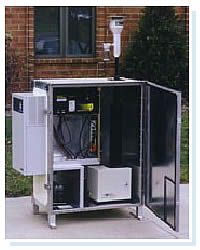How is PM Monitored in New England?

At the time the PM2.5 standards were established in 1997, EPA also issued standard methods for monitoring PM2.5 levels in the ambient air to determine which parts of the country were subject to unhealthy levels. EPA New England worked closely with the New England states to deploy a region wide network of PM2.5 ambient air quality monitors.
On September 27, 2006, EPA amended its national air quality monitoring requirements, including those for PM monitoring. The changes will help EPA, states, and local agencies improve their measurement of air quality, and take advantage of improvements in monitoring technology. Under this rule, many of the existing PM10 monitors will remain in place, especially in areas that exceed the 24-hour PM10 standard. State may choose to shut down monitors that either are redundant or are measuring air quality concentrations that easily meet the 24-hour PM10 standard. The PM2.5 monitoring network will continue, but some monitors could be moved. Every-day sampling will be required for some sites where concentrations of PM2.5 approach the 24-hour standard for PM2.5, while other sites will operate every third or sixth day. PM2.5 chemical-speciation monitoring will continue at 54 national sites used to track trends in air quality, and in areas to support emission-control strategies. PM2.5 continuous monitoring will continue at many sites to support forecasting and reporting of the Air Quality Index (AQI). In addition, EPA and the states will add measurements of "inhalable coarse particles," (i.e. PM10-2.5) at the 75 multi-pollutant NCore monitoring sites.
The EPA document Revisions to Ambient Air Monitoring Regulations FACT SHEET (PDF) (4 pp, 42 K, about PDF) provides more information on the revised monitoring regulations.
